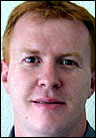Fish Software, a provider of interactive marketing software used at trade shows and consumer events, is adopting an ultrawide-band (UWB) real-time location system (RTLS) to help identify and track event attendees.
Until now, Fish Software has accomplished this using 315 MHz active tags and interrogators provided by Texas RFID provider Axcess International. The tags, which use a proprietary communications protocol, are integrated into attendee badges. By reading these tags, interrogators deployed throughout the trade show floor, and at the entrances to conference session rooms, can track the movements and locations of attendees.
Sometimes, however, RFID works too well. That’s what Fish Software found out when it tried to use the active RFID system to provide trade-show exhibitors with visibility into who was stopping at their booths. The company wanted to track the attendees’ movements, then use Fish Software to provide salespeople working in the booth, via text messaging or other media, with a profile of each person who entered. The profile included the attendee’s name, title and product interests, based on registration survey answers. The problem was that confining interrogation zones to an individual booth—sometimes as small as 10 square feet—so that an attendee’s tag would be read only in that booth, would have meant adding many more readers to the show floor—a very expensive proposition, says Michael Gilvar, president of Fish Software.
To that end, Fish Software decided to seek another solution for this application. Now the company says it has found one, from Ubisense, a Denver-based firm with an ultrawide-band (UWB) real-time location system (RTLS) that Fish Software plans to deploy at a trade show in mid-February.
Fish will work with Ubisense to install an array of four Ubisense tag readers in each booth area. According to Ubisense’s vice president of sales and marketing, Jay Cadman, any two of the four readers in each booth will locate a Ubisense tag, or Ubitag, to within 1 foot inside the booth—a level of accuracy, he claims, that other RFID RTLS platforms can not match, whether they operate at 2.45 GHz or other frequencies. The Ubitags and readers operate from 5.8 to 7.2 GHz, though UWB systems can operate from 3.1 GHz to 10.6 GHz. UWB tags transmit a signal over multiple bands of frequencies simultaneously.
According to Ubisense, what sets its system apart from other RTLS offerings is the combined use of two algorithms—one that calculates the time difference of arrival for a signal at two different RFID readers, and another that calculates the angle of arrival for the signal. This allows the system to pinpoint the location of a tag to within 1 foot. Other location systems use one of these two location methods, but by using both, Ubisense says it needs fewer readers than others using only the time-difference algorithm.
“Ubisense has opened up a whole new way for us to serve exhibitors,” says Gilvar, adding that Fish is excited to deploy the Ubisense system. The firm will determine where it will use the Ubisense technology, and where it will use the Axcess RFID system, on a case-by-case basis, he says. Gilvar does not envision ever using both systems at the same event, as that would necessitate issuing two different active tags to attendees. The Ubisense technology, however, could be used to gather the general traffic-flow data and conference –session-attendance information event organizers require.
For the exhibitor application in February, Ubisense software will feed tag-ID and location information—e.g., tag XYZ in booth 123—into software Fish is developing to correlate the tag ID with the attendee’s profile and send that information to salespeople in the booth. Staff members in the booth will then be able to use PC tablets to determine who is in the booth at a given time. Once they make contact with a specific attendee, they will also be able to log their conversation details into a file to which they can later refer for post-show correspondences with that person.
On the exhibit floor, Gilvar explains, salespeople have difficulty knowing how to target pitches to attendees until they ask a number of questions and learn what interests that person. Having this information up front, in the form of the attendee’s profile, a salesperson will be able to target their pitch more quickly and effectively, says Gilvar. “A salesperson might sell the same product to managers, CEOs and others within a company, but they might have different ways of approaching each of those types of people,” he says.


